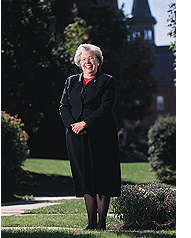
| SEARCH |
| YELLOW PAGES |
| WHITE PAGES |
| UVM HOME |

 Spring President’s Perspective
Spring President’s Perspective
As we entered the year 2000, one phase of our university’s Strategic Change Process came to a close. In January, the campus steering group for Strategic Change issued its report — a wide-ranging document developed through dialogue and discussion involving faculty, staff, students, and alumni. The report states very clearly the key issues before the university and first steps to move us in the right direction. I invite you to review the entire report on the President’s Office homepage http://www.uvm.edu/president.
Part of this process, of course, has been determining our priorities — not only what we are able to do, but what we are able to do to the level of excellence that is UVM’s standard. I was very pleased to see these words emerge from one section of the Strategic Change Process report: “If there is one element in this process that seems to have drawn a voice of consensus, it is the belief that a high-quality experience for students is at the heart of the university mission. Attention to this must inform our thinking in all that we do.”
It is not a startling statement, perhaps, but one which crystallizes a core reason for our being. “A high quality experience for students” is the product of so many elements of this university. It begins, of course, in the classroom with the crucial connection between faculty and students, but it also extends to our on-campus residential life, our use of technology, our diversity, our sense of community, our commitment to an ethic of student-centered service, and many other aspects of this institution. In many cases, the Strategic Change Process has identified areas where UVM can improve the student experience not by adding something new, but by enhancing and expanding already existing initiatives. Allow me to share a few examples.
In the past several years, UVM has increased resources available to increase opportunities for undergraduates to work closely with faculty on research projects. The success of this program has resulted in faculty and students alike calling for greater emphasis and more opportunity in this area. This is one area where the benefits of investment are many — supporting faculty research, the rigor of undergraduate academics, and the sense of community and connection on campus.
Our Center for Teaching and Learning, established just two years ago, has created a central campus hub where our faculty can come together to learn from one another and from experts outside of the university about new ways to grow and continually reach for their full potential as teachers. This semester, with support from the Kellogg Foundation, the center has sponsored the new Faculty Service-Learning Fellowship Program, an initiative to help faculty integrate service-learning into the curriculum and give students more opportunities to reflect on meaningful community participation and how it connects to the academic experience.
First-year programs in units such as the colleges of Agriculture and Life Sciences, and Arts and Sciences are creating immediate connections with peers and with senior faculty for our new students. Looking to the model of these excellent programs, we will be creating a campuswide initiative to connect with every first-year student at UVM. Our program will be both academic and extra-curricular, designed to set the groundwork for the expectations we have of UVM graduates.
Whether examining the undergraduate experience, the condition of campus facilities, or the role of research and scholarship, our Strategic Change Process has not been about the unveiling of a “new” UVM, but rather a key step within a mindset of continuous assessment and commitment to improvement. I’m fond of saying that decision-making is not a single event. It is a continuum. I thank you for your support and welcome your input as we shape the future of our university.